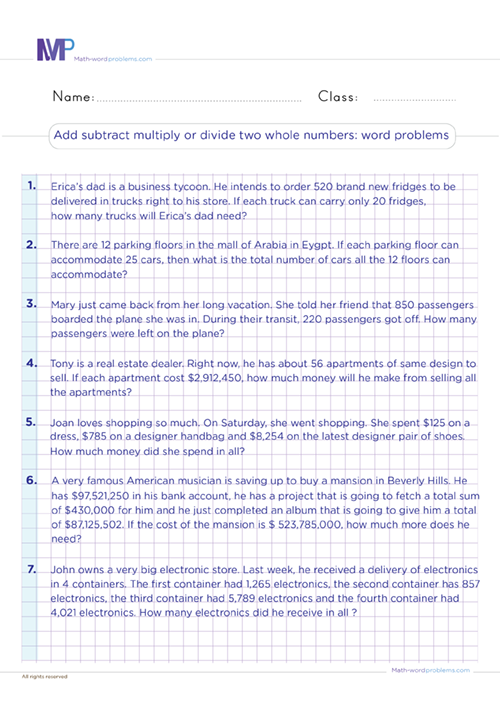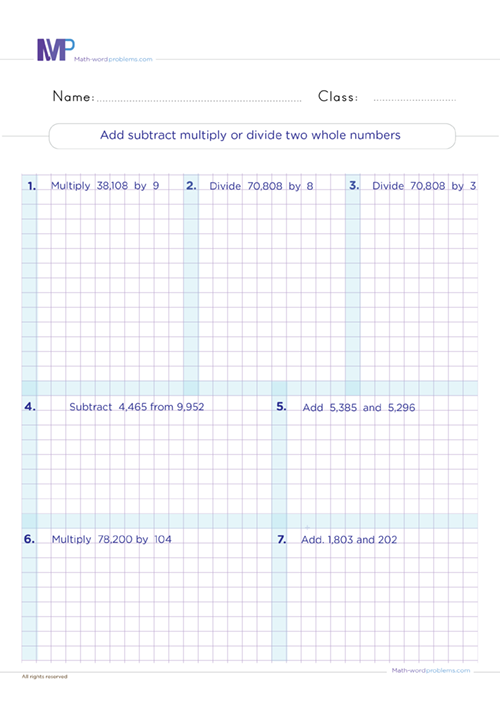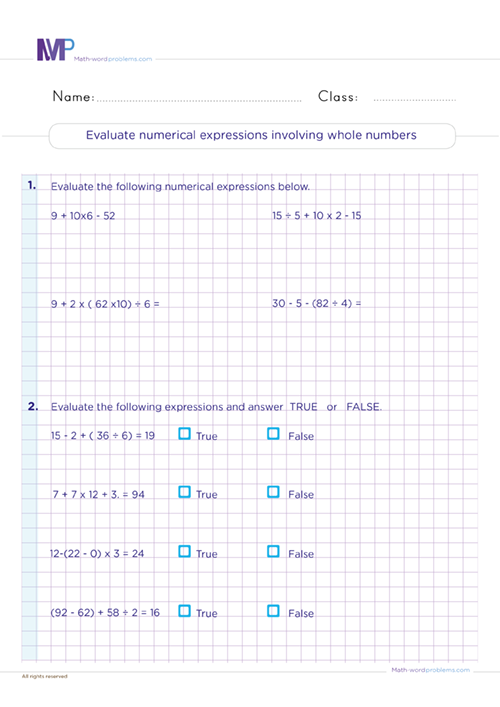 How to add, subtract, multiply and divide whole numbers word problems
How to add, subtract, multiply and divide whole numbers word problems

- INTRODUCTION
- Step1 Identify
- Step 2 STRATEGIZE
- Step 3 SET UP
- Step 4 PROVIDE A SOLUTION
- Step 5 CHECK YOUR WORK
Get more contents on this skill...
Wondering how to add, subtract, multiply and divide whole numbers word problems? Think no more. Here is a captivating step-by-step guide on tackling whole number problems in less time. Actually, this excellent guide stands out from the rest because our focus is to provide sixth graders with a schema-based representation of word problems.
As your kids engage in this resource, you’ll be surprised to notice how they can now easily organize and solve word problems of all kinds. Thus, we are here to inspire and reinforce their working memory to transform word problems into concrete math equations, thus facilitating the solution to the problem.
Steps to Solve addition, subtraction, multiplication, and division of whole numbers word Problems
Here are motivating steps to solve addition, subtraction, multiplication, and division of whole numbers word problems.
As mentioned above, we present a schema-based (instruction and solution) form for your kids.
When it comes to problem schema-based instruction, kids will learn how to identify the problem structure or the problem statement and figure out what the problem will look like in their minds. This means they will try to picture the problem or retell it in their own words. Hence, they will have a complete representation of the word problem. With this in mind, kids will be eager to transform the word problem into a solvable mathematical equation, thus bringing out an accurate answer effortlessly.
To demonstrate how this works, we have added interesting real-life examples below that will excite kids to try more and more challenging word problems.
Step 1: IDENTIFY:
As you begin to read these word problems, you have to first of all figure out the important numbers and keywords in the word problem.
- In case it is adding whole numbers word problems, then expect to see at least one of the keywords below: - add, plus, more, total, increase, together, Altogether, combined, sum, grow, join, both, in all, and, how many in all, how much, spend in all, etc.
- On the occasion that it is subtracting whole numbers word problems, then one of the best keywords below will definitely be in the word problem: - less, minus, take away, left, decrease, difference, fewer, deduct, remain, change, how many more, left over, less than, how much longer/shorter, how much more, fewer than, discount, etc.
- If it is multiplying whole numbers word problems, then you will see at least one of the keywords below in the word problem: - times, multiplied by, product, product of, factor, of, multiply, times, multiple, double, triple, groups, by, twice, area, equal groups, every, in all, total, increased by, as much, each, lots of, groups of, per, etc.
- Whenever it is dividing whole numbers word problems, then you will surely see at least one of the keywords below in the word problem: - divide, half, evenly, every, per, parts, out of, quotient of, ratio of, how many in each, equal parts, cut up, average, as much, etc.
- ***One key Element for learners to understand is that they should not always rely on keywords alone. That is to say; the same keyword can have different meanings in different word problems.
- For this reason, we reiterate on the importance of reading the question very carefully to understand the situation that the word problem is describing, then figure out exactly which operation to use***
Step 2: STRATEGIZE:
How will you solve or tackle the word problem?
- Now, from the keyword(s) in the word problem, you will easily know if you will add, subtract, multiply or divide.
- However, it would be best not to rely only on keywords. Instead, try to understand the situation that the problem is describing before you start to solve the problem.
- Next, after knowing which operation you will perform, construct short expressions/sentences to illustrate the given word problem.
Step 3: SET UP:
Here, we will need to write down a numerical expression that portrays the information given in the word problem.
Step 4: PROVIDE A SOLUTION:
From Step 3 above, add, subtract, multiply or divide the whole numbers. Do not forget the sign if any.
Step 5: CHECK YOUR WORK:
Examples on how to do addition, subtraction, multiplication, and division of whole numbers word problems
Example one: Here is how to add whole numbers word problems.
Step 1: As we move on after reading the question, the important numbers here are $125, $785, and $8,254. Also, the keyword(s) found in the word problem is “spend in all.”
Step 2: Now, how will you solve the problem? From the situation that the problem is describing and the keyword(s) “spend in all” found in the word problem calls for you to perform an addition operation.
As illustrated below, construct short expressions/sentences to represent the given word problem.
- Amount of money she spent on the dress = $125
- Amount of money she spent on the designer handbag = $785
- Amount of money she spent on the pair of designer shoes = $8,254
- Therefore, the amount of money she spent in all = the amount of money she spent on the dress + the amount of money spent on the designer handbag + the amount of money she spent on the pair of designer shoes
Step 3: Now, write down a numerical expression to represent the bolded sentence in step 2 above:
$125 + $785 + $8,254 = ?
Step 4: Form step 3 above, arrange or stack the values so their place values line up (i.e., the column method). Then, go ahead and add the values.
So, she spent $9,164 in all.
Step 5: Finally, check out your work to know if your answer makes sense, i.e., by estimating the numbers and calculating mentally. If the estimated answer is so close to the one you have, then your answer is correct but if the answer is not close to your answer, you’ll have to go back to step 1.
Example two: How to subtract whole numbers word problems.
Step 1: From th word problem, the important numbers are $451,254,900 and $26,600,582. Furthermore, the keyword(s) found in the word problem is “how much more.”
Step 2:Next, how will you solve the problem? You see that the scenario that the word problem presents and the keyword(s) “how much more” calls for you to use a subtraction operation.
Now, after knowing which operation you will perform, construct short expressions/sentences to represent the given word problem, as shown below.
- Amount of money Rita has in her trust fund = $26,600,582.
- Amount of money Charles has in his trust fund = $451,254,900.
- Therefore, the amount of more money Charles has in his trust fund than Rita = the amount of money Charles has in his trust fund – the amount of money Rita has in her trust fund.
Step 3: Now, you have to write down a numerical expression to represent the bolded sentence in step 2 above:
$451,254,900 – $26, 600,582 = ?
Step 4: From step 3 above, arrange or stack the values so that their place values should line up (i.e., use the column method of subtraction). Then, go ahead and subtract the values. Always remember to add the unit of measurement to your final answer if any.
So, Charles has $424,654,318 more in his trust fun than Rita.
Step 5: Finally, check out your work i.e. if the answer makes sense by estimating the numbers and doing mental calculation. If the answer is so close to the one you have, then your answer is correct but if the answer is not close to your answer, then go back to step 1.
Example three: How to solve division of whole numbers word problems.
Step 1: Right now, the important numbers here are 50,289,785 and 455 after carefully reading the word problem in-between the lines. As you continue reading the word problem, the keyword(s) found in the word problem are “each”, and “how many”.
Step 2:Now, how will you solve the problem? As you can see, from the situation that the word problem is describing and the keyword(s) found in the word problem calls for you to carry out a division operation.
Next, after knowing which operation you are going to perform, Construct short expressions/sentences to represent the given word problem.
- Number of books to be placed on shelves = 50,289,785
- Number of books each shelf can hold = 455
- Therefore, number of shelves in the library = Number of books to be placed on shelves ÷ Number of books each shelf can hold.
Step 3: Now, you have to write down a numerical expression to represent the bolded sentence in step 2 above:
50,289,785 ÷ 455 = ?
Step 4: From step 3 above, Set up a long division sign, arrange the numbers on it and then solve (follow the long division steps). Not forgetting to add the unit of measurement to your final answer if any.
So, there are 110,527 shelves in the library.
Step 5: Finally, check out your work i.e. if the answer makes sense by estimating the numbers and doing mental calculation. If the answer is so close to the one you have, then your answer is correct but if the answer is not close to your answer, then go back to step 1.
Example four: Here is an example of how to multiply whole numbers word problems.
Step 1: First, read the problem well and try to figure out the important numbers which are 89,785 and 125. Also, the keyword(s) found in the word problem is “how many” and “each”.
Step 2: Next, how will you solve the problem? The keyword(s) found in the word problem calls for you to perform a multiplication operation.
Now, after knowing which operation you are going to perform, Construct short expressions/sentences to represent the given word problem.
- Number of bags of apples Victoria harvested = 89,785 bags
- Number of apples in each bag = 125
- Therefore, number of apples she harvested = Number of bags of apples Victoria harvested × Number of apples in each bag.
Step 3: Now, you have to write down a numerical expression to represent the bolded sentence in step 2 above:
89,785 × 125 = ?
Step 4: From step 3 above, multiply the numbers using regrouping or any other multiplication methods like long multiplication, grid multiplication, and lattice method to determine the result. Always remember to add the unit of measurement to the final result if any.
Using the long multiplication method, we have
So, she harvested 11,223,125 apples
Step 5: Finally, check out your work to know if your answer makes sense, i.e., by estimating the numbers and calculating mentally. If the estimated answer is so close to the one you have, then your answer is correct, but if the answer is not close to your answer, you’ll have to go back to step 1.





